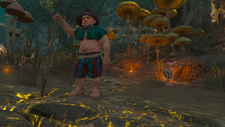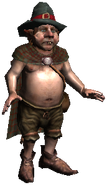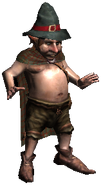| This article is about the small garden gnome-like creatures. For the doppler in The Witcher 3: Wild Hunt, see Imp. |
A Grigg, or Imp, is a tiny humanoid known on both sides of the Yaruga as a mischievous but harmless being found in the countryside, forests, and, at times, in underground crypts.
Culture[]
The griggs of Murky Waters appear to be divided into two tribes: the so-called "good" tribe and a "bad" tribe. The good tribe inhabits the area between a local bridge to the fields and the riverbank, while the "bad" tribe has taken up residence in one of the deeper chambers of the crypt in the fields.
They seem to worship or revere santons, which they treat as chapels and hide their precious cat harnesses in. Another important symbol, standing for joy and friendship, is four-leaf clover – a man who carries it is uninterrupted by griggs during his or her work.[1] Once upon a time, priests from the Old Erem tried to convert some forest imps, reportedly with little success.[2] A term "pagan imp" is nowadays used by the clergy.[3]
Characteristics[]
Appearance[]
Griggs are quite possibly the smallest of the recognized races. When standing next to a human they reach to his knee at best and due to this, an unruly child is sometimes called a "foolish imp".[4] Since the height would never allow them to sit on a horse, they mount cats.
A grigg is usually fat, has a broad nose and pointed ears and very much likes to wear some sort of hat.[1]
Personality[]
Griggs are vivid and joyful and despite being rather mischievous at all time, pissing in milk,[5] tangling horse manes and exhibiting a marked appreciation for alcohol, they hardly injure someone permanently and tend to not be vicious.[1]
Notes[]

- In Danusia Stok's translation of The Last Wish they are called "imps", in David French's translation of Season of Storms they are called "forest spirits", while in the English version of The Witcher game they are called "griggs".
- In The Last Wish, Geralt talked to residents in Upper Posada about finding work for a witcher. One villager declared they had imps, which tangled horse manes in the night. However, this and many of the other so called troublesome creatures were just folklore and Geralt summarily left the area to find legitimate cases.
- In Blood and Wine expansion, there is a Grigg Village in the Land of a Thousand Fables. Uninterrupted, they collect herbs, hoe ground and cut mushrooms. But if Geralt comes closer, they shout and run to their huts.
- In The Witcher, griggs are central to Small Problems quest. They disagree with the construction of a bridge and let it be known with nightly vandalism, much to the consternation of the local Mason Harn and his son, Pat. They are also seen in The Ancient Cemetaur.
Trivia[]
- Although there are no references to the Griggs specifically in Anglo-Saxon culture and folklore, their model resembles a typical Irish goblin, of which the clover is a symbol and a reference. Nevertheless, the Griggs are somewhat similar to the Pookas or leprechauns, creatures of the Irish mythology.
- In Polish folklore, their name is "skrzaty" (singular: "skrzat"), also known as "krasnoludki" (singular: "krasnoludek"). They are minute folk, most of time friendly. During the day, they hid under the doorstep, behind the stove, in the mouse burrows, or in the nooks and crannies of the forge or stables; by night, they do housework and protect the children from evil ghosts.







